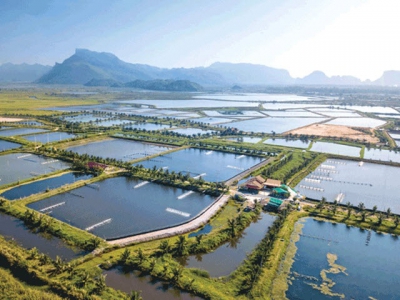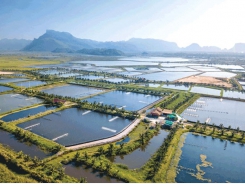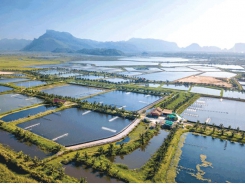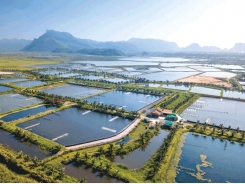Land Based Sustainable Aquaculture Strategy - Part 11

15/ Monitoring
PREFERRED MANAGEMENT
Provide for regular monitoring of dissolved oxygen (DO), pH, temperature, ammonia, nitrite, nitrate and alkalinity.
Pond aquaculture should be monitored for water quality (DO, pH, temperature, TAN, ammonia)at least twice a week in summer. Tank aquaculture systems should be monitored for water quality daily (DO, ammonia, nitrite, nitrate, alkalinity, pH, salinity and temperature). Meters should be of high quality and calibrated regularly (once/week).
Discharge of reconditioned waste water
I&I NSW Policy!
It is I&I NSW policy that intensive freshwater aquaculture farms are not permitted to directly discharge water to natural waterbodies or wetlands (exception for approved open (flow through)systems).
Be aware!
Aquaculture farms discharging water (fresh, estuarine, marine or saline ground waters) to natural waterways may require a licence issued by DECCW under the Protection of the Environment Operations Act 1997. Discharge structures placed in, on or within 40 metres of a water source will require a controlled activity approval for their construction under the Water Management Act 2000.
Land based aquaculture systems should endeavour to recirculate as much water as possible.
The management of the ecological processes within the reconditioning areas or tanks can significantly improve discharge water quality prior to its return to the culture unit, reuse system or the environment (if permitted).
Aquaculture farms that are permitted to discharge water to natural waterbodies must manage this water to ensure it complies with the conditions of the aquaculture permit, the development consent and any licence issued by DECCW under the Protection of the Environment Operations Act 1997 (POEO Act).
The DECCW licence conditions including load and concentration limits, and monitoring and reporting requirements will be determined on a case by case basis. These conditions will be developed with a view to maintaining the NSW Government Water Quality and River Flow Interim Environmental Objectives (WQOs) in the relevant catchment.
Where oyster leases or major fishing grounds are located nearby, there may be additional requirements for protection of water quality for safe consumption of aquatic foods. In the event of a disease issue, I&I NSW may order the farm water to be quarantined with no discharge being permitted from the premises.
Freshwater that can not be discharged to natural waterbodies or wetlands can be managed in the following ways:
- retained in a discharge pond and recycled in the aquaculture enterprise;
- discharged via town sewerage infrastructure (trade waste agreement);
- stored and utilised for agriculture, hydroponics or horticulture; or
- disposed of by irrigation or evaporation.
Monitoring quantity and quality of discharge
DECCW licences for aquaculture will usually be set for a number of parameters, including BOD, NFR, TP, TN, DO and pH. The licences may place limits on the daily discharge from the farm (eg. 10,000kL/day). The licence will set out how the discharge volume is to be monitored and calculated.
Monitoring of above parameters and an annual statement of compliance is required under the POEO Act.
Substituting raw water with discharge water
As part of an integrated freshwater aquaculture farming enterprise, horticultural or agricultural crops may utilise discharge water instead of raw water. Other uses on an aquaculture farm may include irrigation of landscaping or gardens. In some locations, it may be possible to transfer discharge water to neighbouring properties for irrigation use. Provision must be made to store discharge water during rainy periods. Discharge ponds should be constructed with plenty of leeway and runoff from surrounding land must not be captured. Land for irrigation should not be within 50 metres of a natural waterbody.
When irrigating with discharge water, the following factors should be considered:
- soil characteristics (plant growth, permeability);
- avoiding sloping land unless drip irrigation;
- efficient application methods, metering/monitoring so not to over water;
- adequate erosion management provisions;
- avoiding land with salinity or potential salinity problems.
Under normal circumstances where water is used as a substitute for raw water, specific licence conditions for its use are not required.
Related news
Tools

Phối trộn thức ăn chăn nuôi

Pha dung dịch thủy canh

Định mức cho tôm ăn

Phối trộn phân bón NPK

Xác định tỷ lệ tôm sống

Chuyển đổi đơn vị phân bón

Xác định công suất sục khí

Chuyển đổi đơn vị tôm

Tính diện tích nhà kính

Tính thể tích ao




 Land Based Sustainable Aquaculture Strategy - Part 12
Land Based Sustainable Aquaculture Strategy - Part 12  Land Based Sustainable Aquaculture Strategy - Part 10
Land Based Sustainable Aquaculture Strategy - Part 10